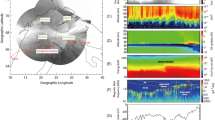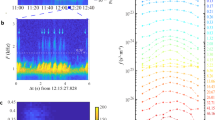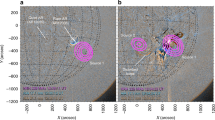Abstract
The direct observation of high frequency ∼3 Hz modulation of electron intensities during pulsating aurora is comparatively recent although, from TV and photometric studies, modulation of the visual aurora at these frequencies has been recognized for over a decade. We report here 2.2 ± 0.5 Hz oscillations in the intensities of 4–25 keV electrons producing a pulsating aurora. The electrons were measured from a Petrel sounding rocket launched from Kiruna, Sweden on 25 January 1979. The oscillations like the slower 1–20 s pulsations, exhibit a marked velocity dispersion implying an equatorial origin for both forms of modulation. VLF—hiss observed at about the same time at the Satellite GEOS 2, operating in the same equatorial region, shows remarkable similarities to the modulation in the particle fluxes. A connection between VLF emissions and auroral pulsations has been suggested by Coriniti and Kennel who argue that low frequency, 5–300 s period, micropulsations modulate whistler-mode wave amplitudes leading to variations in the rate of pitch-angle scattering of electrons from the magnetosphere. The isotropic angular distributions reported here suggest that this mechanism acting alone cannot explain the modulation in the present case.
This is a preview of subscription content, access via your institution
Access options
Subscribe to this journal
Receive 51 print issues and online access
$199.00 per year
only $3.90 per issue
Buy this article
- Purchase on Springer Link
- Instant access to full article PDF
Prices may be subject to local taxes which are calculated during checkout
Similar content being viewed by others
References
Bryant, D. A. Rep. 3rd Workshop on IMS observations in Northern Europe, Skokloster (1979).
Basto, R. A. & Raitt, W. J. Planet Space Sci. 26, 21 (1978).
Sandahl, I., Ellasson, L. & Lundin, R. Geophys. Res. Lett. (in the press).
Royrvik, O. & Davis, T. N. J. Geophys. Res., 82, 4720 (1977).
Pemberton, E. V. & Shepherd, G. G. Can. J. Phys. 53, 504 (1975).
Bryant, D. A., Collin, H. L., Courtier, G. M. & Johnstone, A. D. Nature 215, 45 (1967).
Bryant, D. A., Courtier, G. M. & Bennett, G. J. atmos. terr. Phys., 33, 859 (1971).
Bryant, D. A., Smith, M. J. & Courtier, G. M. Planet. Space Sci., 23, 867 (1975).
Hones, E. W., Ashbridge, J.R. & Bame, S.J. Rep. 2nd General Scientific Assembly of the Int. Ass. Geomagnetism and Aeronomy, Kyoto (1973).
Coroniti, F. V. & Kennel, C. F. J. geophys. Res. 75, 1279 (1970).
Johnstone, A. D. Nature 274, 119 (1978).
Smith, M. J., Bryant, D. A. & Edwards, T. E. J. atmos. terr. Phys. 42, 167 (1980).
Author information
Authors and Affiliations
Rights and permissions
About this article
Cite this article
Lepine, D., Bryant, D. & Hall, D. A 2.2-Hz modulation of auroral electrons imposed at the geomagnetic equator. Nature 286, 469–471 (1980). https://doi.org/10.1038/286469a0
Received:
Accepted:
Issue Date:
DOI: https://doi.org/10.1038/286469a0
This article is cited by
-
A statistical study of daytime pulsing hiss emission at low latitudes
Indian Journal of Physics (2013)
-
Quasi-periodic VLF emissions observed during daytime at a low latitude Indian ground station Jammu
Journal of Earth System Science (2009)
Comments
By submitting a comment you agree to abide by our Terms and Community Guidelines. If you find something abusive or that does not comply with our terms or guidelines please flag it as inappropriate.



